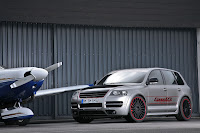
Sitting before you is a W12 Touareg Sport Edition swathed in matte gunmetal and gloss-black CFC film, brought to you by Erftstadt-based CoverEFX. The gloss black also gets around to touch-up duty on all trim, including mirrors, vents, and other "hang-on parts", while the tail-lights get a glazed-and-hazed treatment.
But what does CoverEFX have to say about the windows?
"The room climate is optimized – and the "anthracite-style" glass tinting on all windows of the vehicle is a perfect match to this. Sunscreening film contributes to the general sense of well-being, and the living is just better in a room with comfortably adjusted temperature." Plain terms: they're tinted.

There's also some chassis tuning, but the firm failed to go into details other than, "Electronic equipment makes the chassis even more sportish, and yet comfortable at the same time. The body lowering has been optimized electronically at the chassis level. So now where other powerful vehicles lose their stability, the W12 Sport Edition easily maintains its steadiness on the road."
Lastly, CoverEFX's behemoth rolls on 22-inch powder-coated Kahn RS-L alloys wrapped in Pirelli Scorpions and..."refined"...with red pinstriping.
This one's limited to just 500 units priced at €140,500 (~$189,000), so get them while they're around.
By Phil Alex
















































































